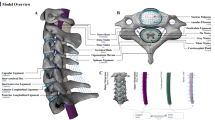Abstract
Cervical myelopathy results in loss of nerves functions along the spinal cord below the damage area as it is the result of spinal cord compression which nowadays always occur during traffic accidents. Patients with cervical myelopathy do not necessarily share the same symptoms. These vary according to the degree of cervical cord compression and cross sectional shape at every segment of cervical cord which caused difficulties in diagnosis. In this study, two dimension model of every cervical cord segment were built. Then, differences of compression results in every segment were verified. After that, to verify the effects of compression to other segments, three dimensions model of cervical cord model is built. From this study, we can see that cervical cord with flat shaped gray matter have higher stress distribution than cervical cord with hill shaped grey matter. Other than that, the injury start occurred in ventral column of white matter instead of gray matter during early injury stage.
Access this chapter
Tax calculation will be finalised at checkout
Purchases are for personal use only
Similar content being viewed by others
References
Kameyama, T., Hashizume, Y., Sobue, G.: Morphologic features of the normal human cadaveric spinal cord. SPINE 21(11), 1285–1290 (1996)
Ichihara, K., Taguchi, T., Shimada, Y., Sakuramoto, I., Kawano, S., Kawai, S.: Gray matter of the bovine cervical spinal cord is mechanically more rigid and fragile than the white matter. J. Neurotrauma 18(3), 361–367 (2001)
Author information
Authors and Affiliations
Corresponding author
Editor information
Editors and Affiliations
Rights and permissions
Copyright information
© 2016 Springer International Publishing Switzerland
About this paper
Cite this paper
Shaari, N.F.B., Ohgi, J., Nishida, N., Chen, X., Sakuramoto, I., Taguchi, T. (2016). Simulation of Cervical Cord Compression Using Finite Element Method (FEM). In: Chen, YW., Torro, C., Tanaka, S., Howlett, R., C. Jain, L. (eds) Innovation in Medicine and Healthcare 2015. Smart Innovation, Systems and Technologies, vol 45. Springer, Cham. https://doi.org/10.1007/978-3-319-23024-5_10
Download citation
DOI: https://doi.org/10.1007/978-3-319-23024-5_10
Published:
Publisher Name: Springer, Cham
Print ISBN: 978-3-319-23023-8
Online ISBN: 978-3-319-23024-5
eBook Packages: EngineeringEngineering (R0)




